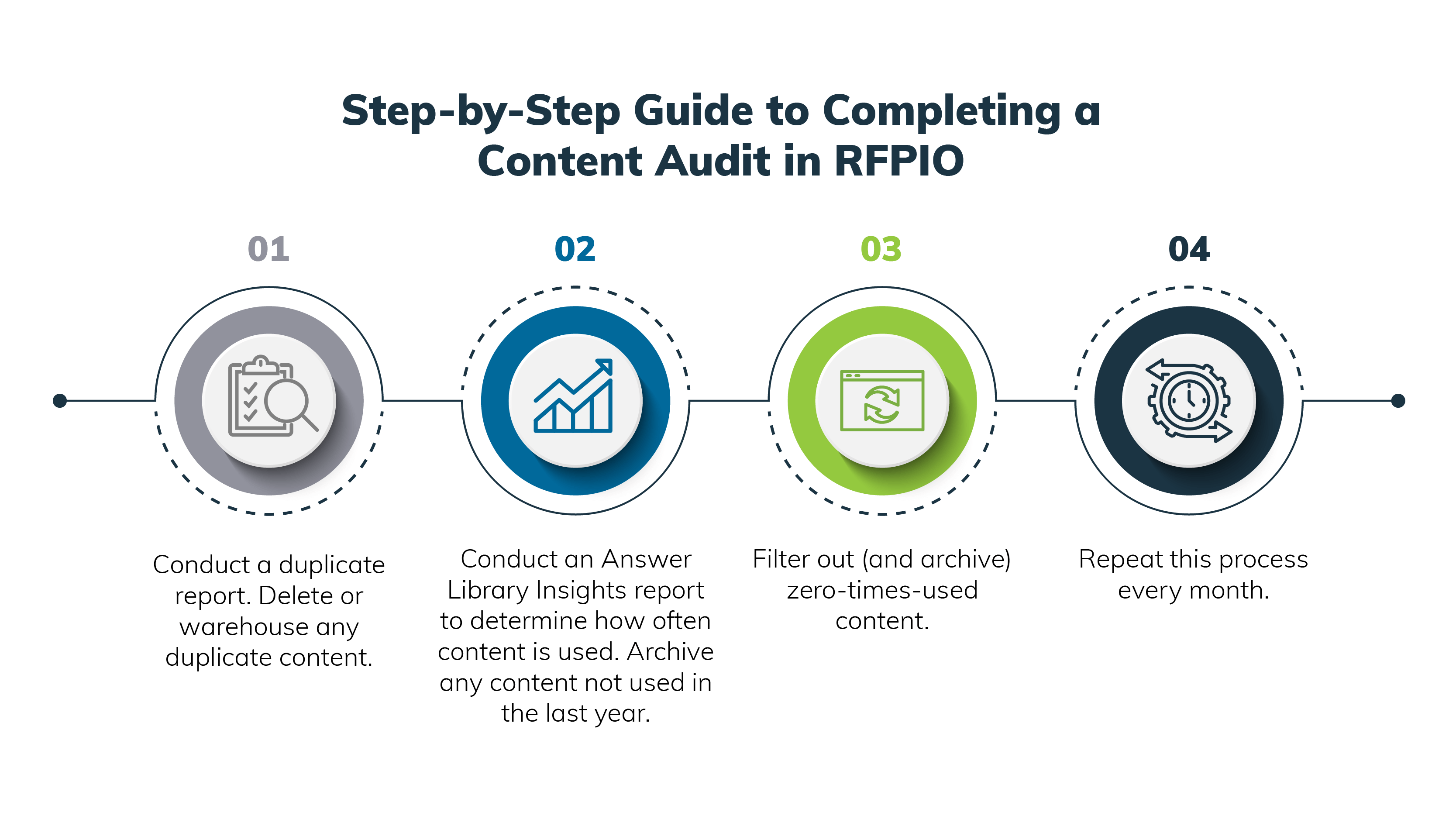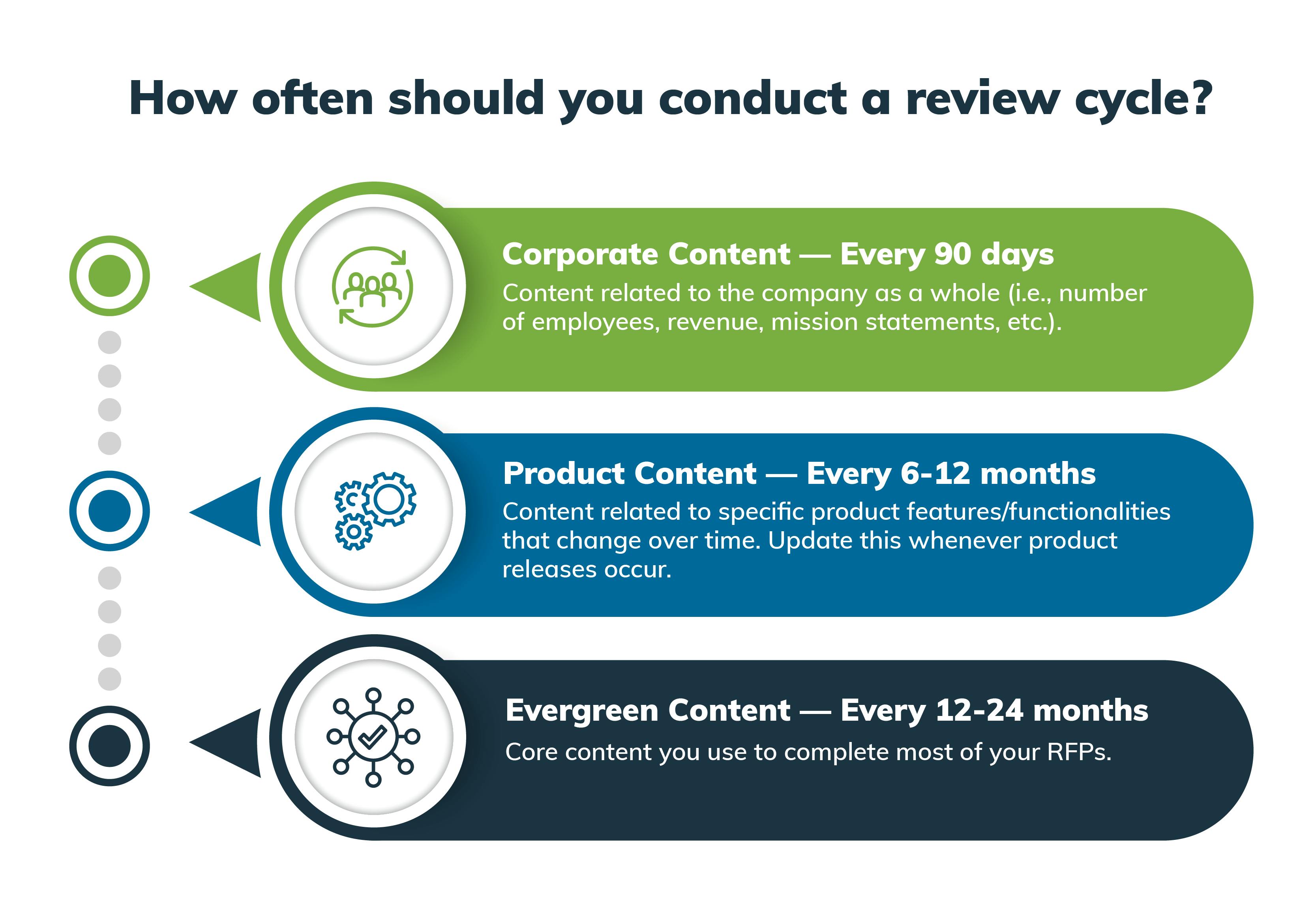It’s time to show your RFP content who’s boss. And, yes, a healthy content library does more than just keep you sane. It also streamlines your RFP response process. Note that I say “RFP”, but I really mean any kind of complex questionnaire… RFIs, Security Questionnaires, DDQs, VSAs, you name it.
If you’re already working with RFP automation software like RFPIO, a healthy Content Library means answering 70-80% of your RFP with one click (hello, Auto Respond!).
Even if you haven’t upgraded to RFP automation software yet, refreshing your content library means you can bring relevant content to your fingertips and respond to a vast majority of RFP questions at the drop of a hat.
The good news is that an RFP content audit isn’t nearly as scary as it sounds. Read on to learn how to conduct your content audit in just three steps.
RFP content audit step 1: Complete an ROT analysis
ROT stands for “Redundant, Outdated, and Trivial”. A smooth-running live RFP Content Library only contains the most recent, relevant, and accurate information. That means your job is moving redundant, outdated, and trivial content into an archived folder.
Redundant Content: Duplicate and/or similar content. If you’re using RFPIO, run a duplicate report on questions and answers, and click on “View Similar Content” to find comparable responses.
Outdated Content: Expired or sunset content. Isolate any content not used in the last year (let’s call that “expired content”) using the Advanced Search function in RFPIO. Then, identify content from products, services, and solutions that are no longer relevant (we can call that “sunset content”) using tags and/or product names.
Trivial Content: Deal- or client-specific content. Identity trivial content by searching for specific client names.

RFP Content Audit Step 2: Move content out of your active RFP Content Library
Once you do your analysis, you’ll want to move that content out of your active RFP Content Library.
You have two options:
Option 1: Delete it (scary)
Only delete content that you’re sure you’ll never, ever need again. There’s no turning back from deleted content.
Option 2: Warehouse it (less scary, and my preferred method)
Isolate your content and store it in an RFPIO Archived collection. If you’re not using RFPIO, make sure warehoused content is stored in its own location so it doesn’t get confused with your live content.
You can still access warehoused content. You’re still able to bring it into a live project, update it, and push it back into the active RFP Content Library. If you ever find out you need a piece of content that you’ve archived, you don’t have to start with a blank page.
RFP Content Audit Step 3: Set up owners and review cycles
All content in your RFP Content Library should have an assigned owner. The content owner should be the Subject Matter Expert (SME) who is responsible for the accuracy of the answer.
You should also add a moderator, who is responsible for giving the final “white glove” review. The moderator should apply editorial standards to each answer that comes through, ensuring everything that is pushed to the live RFP Content Library is polished.
How often should you conduct a review cycle?
Well… that depends on the content.
For corporate content, I recommend conducting a review cycle every 90 days. Corporate content refers to any content relating to the company as a whole, like number of employees, revenue, mission statements, etc.
For product content, conduct a review cycle every 6-12 months, or anytime a product release occurs. Product content refers to anything related to specific product features or functionalities that change over time.
As far as evergreen content… you might be surprised to learn it isn’t quite as evergreen as you would imagine. Evergreen content is the core content you use to complete most of your RFPs, and you should still review it once every 12-24 months.

A healthy RFP Content Library creates benefits across your entire organization
As you’d expect, a healthy RFP Content Library enables your proposal team to quickly complete RFP responses—answer 70-80% of a proposal with a quick click using “Auto Respond”.
When you can automatically respond to those commonly-seen questions, that means that your team has more time to focus on tailoring each response to your customers’ specific needs.
A healthy RFP Content Library also makes life easier for your SMEs—as I explained in a previous blog, the number one rule of working with SMEs is respecting their time.
When you keep your Content Library impeccably clean, your SMEs don’t need to verify content outside of scheduled review cycles. They’ll have more time to focus on their other job functions, and you’ll have an Content Library full of the most accurate, up-to-date content. Everybody wins
You may think that auditing your RFP content is just a luxury of enterprise companies. I’m here to tell you that anyone and everyone can (and should) regularly audit their content, regardless of whether your team has one person, or 100.
If you’re working with a one or two-person team, follow the steps above to keep your content fresh. Make sure your SMEs understand which content they’re responsible for, and get in the habit of updating content at the appropriate time.
If you’re a larger team, hire a dedicated content manager whose sole focus is keeping your RFP Content Library healthy.
Show your RFP content (and your RFP response process) who’s in charge
You have the tools to complete a successful RFP content audit. It’s time to put your newfound skills to the test!
If you get stuck along the way, check out my webinar below. I’ve demonstrated my step-by-step process for conducting a content audit.

